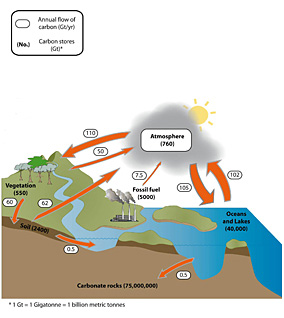Soil carbon
Soils can store, cycle and emit as gases different forms of carbon as part of the carbon cycle process. These forms may be very stable and stay in the soil for thousands of years or may be broken down in just a few hours. Soil stores more carbon than the atmosphere and plants combined.
Soil carbon forms
Soil carbon can occur as organic and inorganic carbon forms.
Organic carbon includes decaying plant matter, soil organisms and microbes, and carbon compounds such as sugars, starches, proteins, carbohydrates, lignins, waxes, resins and organic acids.
Inorganic carbon is mineral-based with the most common form being calcium carbonate.
Soil organic matter influences soil functions and properties and is a vital indicator of soil health as it:
- provides energy for soil microorganisms, nutrient storage and supply (especially nitrogen, phosphorus and sulfur)
- improves soil structure as well as the soil's ability to hold water and resist acidification.
Measuring organic carbon
The amount of organic matter in soil is difficult to measure directly. Laboratory tests actually measure soil organic carbon, which makes up about 58% of total soil organic matter.
Soil organic matter is made up of several ‘pools’ which last for different lengths of time in soil and affect different soil functions. Organic matter and residue deposited in, or on the soil, is the most active pool, but may be rapidly lost.
Humus, made up of decayed organic residues from plants, soil organisms and microbes, is more resistant to breaking down than particulate or active organic matter and is a more stable slow pool. Charcoal is very stable, but is not biologically active, and therefore is an inert or passive pool.
Soil organic carbon is an important global carbon pool, about 3 times larger than the amount of carbon stored in vegetation and twice the amount stored in the atmosphere. In general, organic carbon stocks in Australian soils are much lower than the global average.
Managing organic carbon
Soil cultivation and soil degradation result in loss of organic carbon through release as carbon dioxide (CO2) into the atmosphere.
Land clearing and over-grazing disturb the soil and can contribute to organic carbon loss by removing plant residues off-site and accelerating decomposition of organic matter.
Improved soil management methods such as retaining crop stubble on the soil surface and reducing grazing pressure have the potential to increase the store of soil organic carbon and/or reduce organic carbon loss.


The global carbon cycle
There is as much carbon in the world today as there was millions of years ago.
However, by burning fuels and interacting with soil and vegetation, human activities affect the distribution of carbon between the terrestrial, marine and atmospheric pools of the global carbon cycle.
Benefits of soil organic matter
Soil organic matter and soil carbon are indicators of soil health. Soil organic matter influences a variety of soil functions and properties including by:
- acting as an energy source for micro-organisms and as a supply of nutrients (such as nitrogen, phosphorus and sulfur)
- supporting soil structure by binding particles together into aggregates, which keeps the soil stable—increasing water infiltration and assisting in preventing soil compaction
- increasing pH buffering capacity (the ability of soil to resist changes in pH), which make soils less vulnerable to soil acidification
- preventing leaching losses of plant nutrients like calcium, magnesium and potassium as these are held on soil organic matter.
Improving soil carbon levels
Ways to improve soil carbon levels will vary according to land-use, soil type and climate. As Queensland is a large state, there is large variation in the range of soil conditions.
Grazing lands
Around 85% of Queensland is used for grazing of pasture land. This area includes woodlands, forests, natural grasslands and areas planted to exotic pasture species. General practices for improving soil carbon in grazing lands include:
- having pastures with perennial species; perennial pastures have greater soil carbon inputs than annual pastures.
- managing pastures well so they are not overgrazed or eroded and can produce a higher rate of plant growth—thus increasing or maintaining the level of carbon in the soil.
Cropping lands
Queensland farmers have been very selective in the land they choose to grow crops on as only 2% of the state is used for cropping.
Healthy crops efficiently convert carbon dioxide into plant growth. Practices that may help maintain or increase soil carbon levels in cropping lands include:
- maintaining a healthy soil that makes optimal use of rainfall and irrigation, has adequate levels of plant nutrients, is well aerated, has a close to neutral pH and high levels of biological life
- minimising soil compaction by the adoption of practices such as controlled traffic farming (CTF)
- using green and brown manure crops (green manure crops sprayed with herbicide)
- adopting a pasture phase in a crop rotation system (preferably including a legume)
- adopting zero till or conservation farming practices.
However, adopting a perennial pasture phase is the most promising practice to increase soil carbon levels in cropping lands.
More information
- Soil carbon sequestration (NSW Department of Primary Industries)
- Soil organic matter (Tasmanian Department of Primary Industries, Parks, Water and Environment)
- Soil: Carbon (Australia State of the Environment – 2021)


